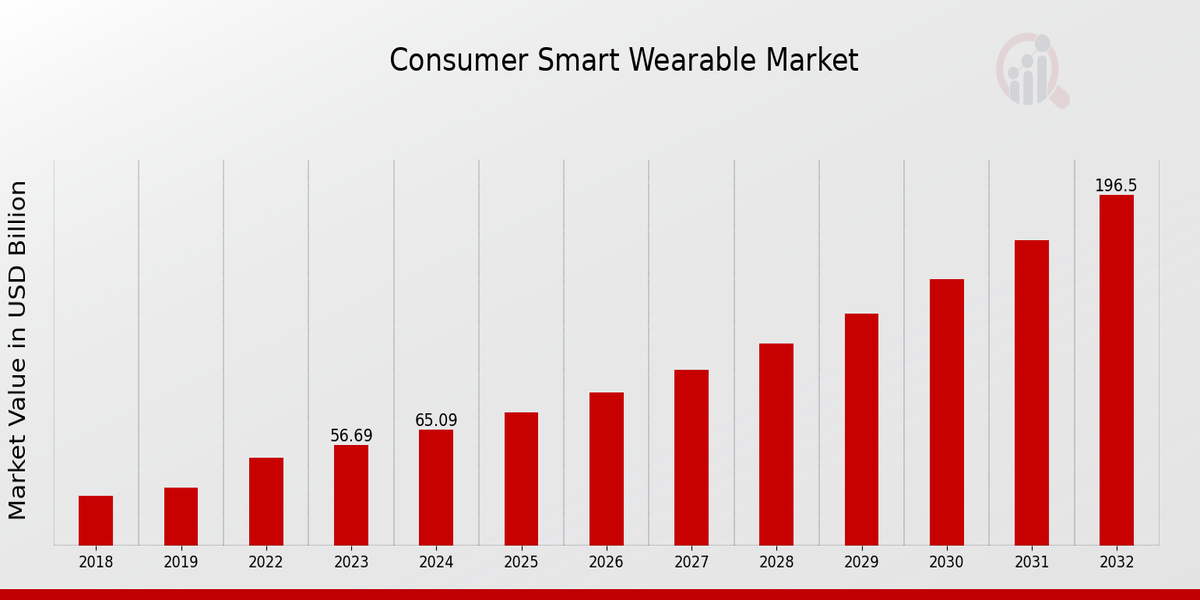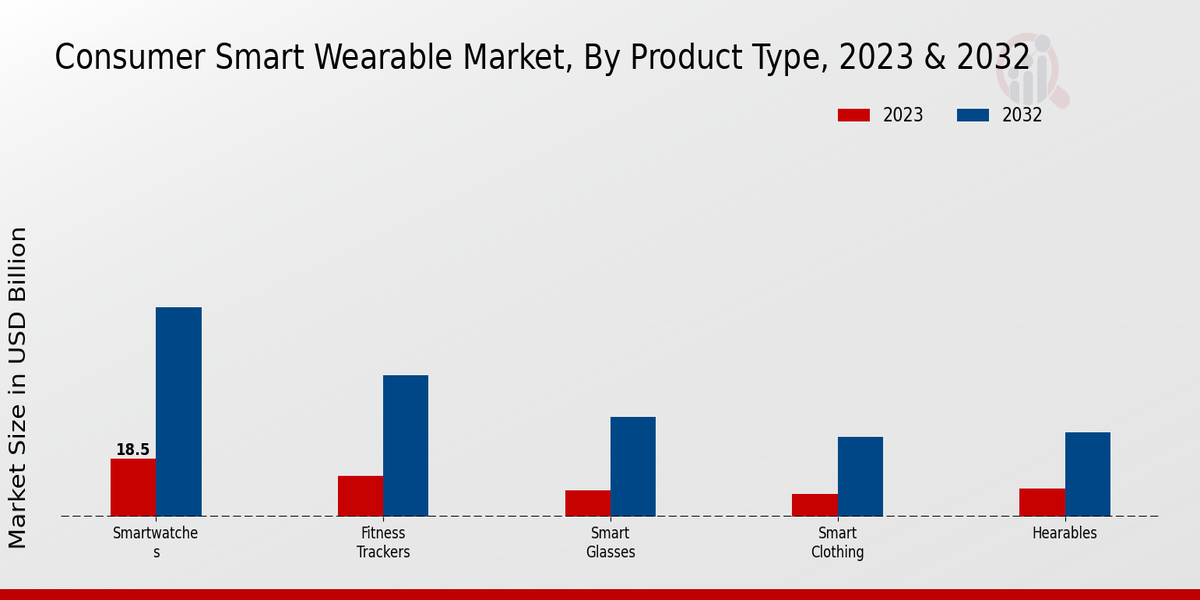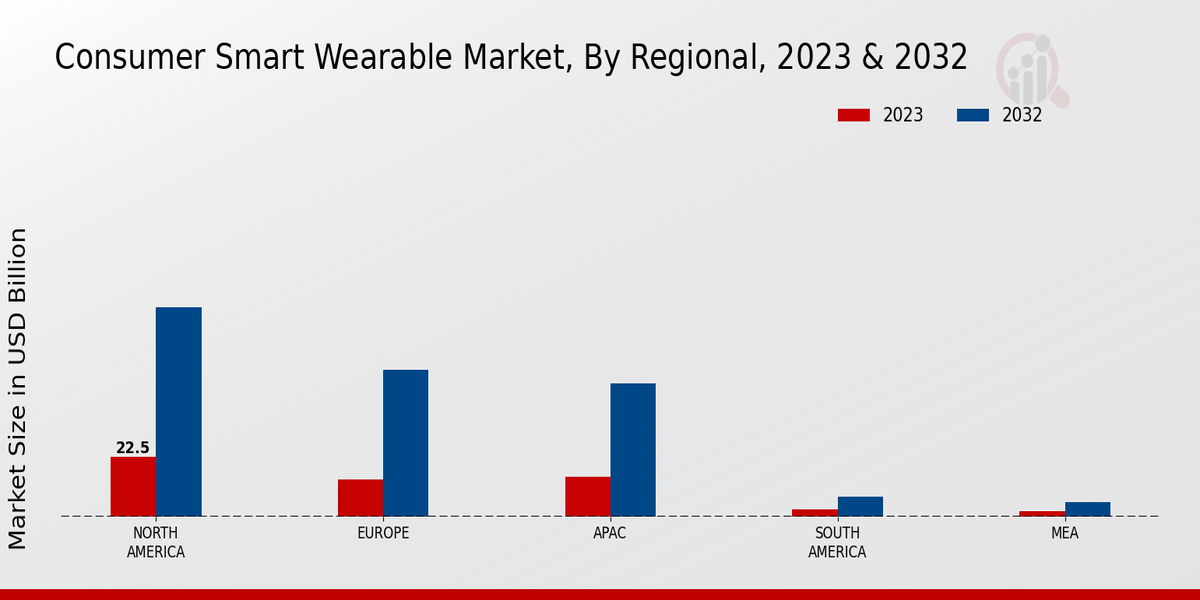Consumer Smart Wearable Market Overview
As per MRFR analysis, the Consumer Smart Wearable Market Size was estimated at 49.38 (USD Billion) in 2022. The Consumer Smart Wearable Market Industry is expected to grow from 56.69(USD Billion) in 2023 to 196.6 (USD Billion) by 2032. The Consumer Smart Wearable Market CAGR (growth rate) is expected to be around 14.81% during the forecast period (2024 - 2032).
Key Consumer Smart Wearable Market Trends Highlighted
The Consumer Smart Wearable Market is influenced by several key market drivers, including the rising health awareness among consumers, advancements in technology, and the growing desire for personalized experiences. As more individuals focus on fitness and overall wellness, smart wearables that monitor health metrics such as heart rate, sleep patterns, and physical activity are becoming increasingly popular. Furthermore, continuous innovation in design and functionality is boosting the appeal of these devices, making them more desirable for everyday use.
The integration of artificial intelligence and machine learning into smart wearables is also enhancing user experience, leading to widespread adoption.Opportunities lie in the expansion of new product categories and integrations with emerging technologies. The market is witnessing a shift towards more specialized devices that cater to various needs, such as stress management, mental health tracking, and chronic disease management. By tapping into these areas, companies can capture a broader audience and meet the diverse preferences of consumers. Additionally, there is a growing trend toward smart clothing and accessories that blend technology seamlessly into everyday wear, creating more opportunities for innovation and market growth.
Recent trends showcase an inclination towards connectivity and compatibility with other devices, such as smartphones and smart home products.Consumers are seeking wearables that not only function independently but also enhance their overall digital experience. Social factors, like community engagement through fitness challenges and shared goals using wearable technology, are significantly influencing purchasing decisions. The focus on sustainability and eco-friendly materials is also gaining traction, prompting brands to adopt responsible practices to align with consumer values. These trends ultimately contribute to a dynamic and evolving market landscape in the realm of smart wearables.

Source: Primary Research, Secondary Research, MRFR Database and Analyst Review
Consumer Smart Wearable Market Drivers
Technological Advancements and Innovations
The Consumer Smart Wearable Market Industry is witnessing a rapid evolution driven by continuous technological advancements and innovations. These innovations not only enhance the functionality of wearables but also expand their applications across various domains such as health, fitness, sports, and entertainment. The integration of sophisticated sensors, artificial intelligence, and machine learning technologies allows wearable devices to deliver real-time health monitoring, personalized insights, and predictive analytics, significantly improving user experience and fostering increased adoption.
Moreover, advancements in battery technology, display features, and miniaturization also contribute to improving the performance and usability of these devices. As consumers become more health-conscious and tech-savvy, the growing demand for features such as heart rate monitoring, sleep tracking, and smart notifications will drive the market further. The influx of startups and established companies alike into the Consumer Smart Wearable Market Industry enhances competition, leading to the rapid development and introduction of novel products, ensuring that consumer needs are met and exceeded.Ultimately, this cycle of innovation fuels widespread acceptance, bolsters market momentum, and shapes its future trajectory.
Increasing Health Awareness and Demand for Fitness Tracking
The Consumer Smart Wearable Market Industry is significantly driven by a growing awareness of health and wellness among consumers. As individuals increasingly prioritize staying healthy and fit, the appeal for devices that offer health-tracking features has surged. Smart wearables equipped with advanced sensors that monitor vital health metrics such as heart rates, oxygen levels, and physical activity levels have become essential companions for many fitness enthusiasts.This trend has led to widespread adoption of wearables among different demographics, triggering sustained growth in the market as consumers seek to monitor their well-being more closely.
Rising Adoption of IoT and Connected Devices
The proliferation of the Internet of Things (IoT) and connected devices plays a pivotal role in driving the Consumer Smart Wearable Market Industry. As homes and workplaces become increasingly interconnected, consumers expect their wearables to integrate seamlessly with other smart devices. This connectivity enhances the functionality of wearables, allowing users to track their fitness progress, receive notifications, and manage various aspects of their daily lives more efficiently.As IoT technology continues to evolve, the ability for wearables to work in conjunction with other devices will further entice consumers, fueling market growth.
Consumer Smart Wearable Market Segment Insights
Consumer Smart Wearable Market Product Type Insights
The Consumer Smart Wearable Market is witnessing substantial growth, particularly within the Product Type segment, where innovative technologies are transforming consumer experiences. As of 2023, the entire market is valued at 56.69 USD Billion, highlighting the robust demand for wearable technologies. Among the various product types, Smartwatches stand out, commanding a significant market valuation of 18.5 USD Billion in 2023 and poised to reach 66.8 USD Billion by 2032, demonstrating their increasing relevance. This product type benefits from a combination of health tracking features, smartphone integration, and customizable options, making it a preferable choice for many consumers.
Following closely, Fitness Trackers currently hold a market value of 13.2 USD Billion in 2023 and are expected to grow to 45.2 USD Billion by 2032. The growing trend of fitness consciousness among consumers significantly drives the popularity of Fitness Trackers, offering features like heart rate monitoring and activity tracking. Smart Glasses also contribute notably to the market, valued at 8.5 USD Billion in 2023, with projections of reaching 32.0 USD Billion by 2032. This segment holds potential for businesses aiming to integrate augmented reality, positioning Smart Glasses as a major player in areas like navigation and immersive gaming.
Smart Clothing, valued at 7.3 USD Billion in 2023 and expected to grow to 25.5 USD Billion by 2032, showcases advancements in fabric technology that enhance athletic performance and health monitoring, appealing to both fitness enthusiasts and tech-savvy consumers. Meanwhile, Hearables are valued at 9.19 USD Billion in 2023, with a future valuation of 27.1 USD Billion in 2032. This segment demonstrates significant growth as consumers seek devices that offer not just audio capabilities but also health tracking, blending convenience and fitness in one device.
Overall, the Consumer Smart Wearable Market segmentation reveals that Smartwatches and Fitness Trackers dominate the landscape, driven by a trend towards health monitoring and connectivity, while Smart Glasses, Smart Clothing, and Hearables also present substantial growth opportunities, underscoring a diverse array of consumer preferences in smart wearable technologies.

Source: Primary Research, Secondary Research, MRFR Database and Analyst Review
Consumer Smart Wearable Market Sensor Type Insights
In 2023, the Consumer Smart Wearable Market was valued at 56.69 billion USD, reflecting a robust demand for advanced technology in personal health and fitness tracking. The Sensor Type segmentation reveals a diverse set of components that contribute to this market growth, with each type playing a vital role. Heart Rate Sensors are essential for monitoring cardiovascular health, facilitating the wellness trend among consumers. GPS Sensors enable outdoor activities like running and cycling, enhancing user experience through accurate location tracking.Accelerometers contribute to movement detection, which is vital for fitness applications, while Gyroscope Sensors provide orientation data, which is significant in wearable gaming and augmented reality experiences.
Bio-metric Sensors are increasingly significant for health monitoring, enabling features like sleep tracking and stress management. The growth in these sensor categories illustrates the evolving landscape of the Consumer Smart Wearable Market, driven by consumer demand for innovations that promote active lifestyles and health-consciousness. Market trends reveal an increased emphasis on user-friendly designs and accurate data collection, while challenges remain in sensor accuracy and battery life.Overall, this segment reflects a promising trajectory as technology continues to advance within the industry.
Consumer Smart Wearable Market Connectivity Insights
The Consumer Smart Wearable Market revenue related to the Connectivity segment is set to experience substantial growth, with the complete market valued at 56.69 billion USD in 2023 and projected to reach 196.6 billion USD by 2032. The expected rapid growth is driven by increasing consumer demand for smart devices that offer seamless connectivity. Connectivity methods such as Bluetooth are of significant importance in this market, enabling users to connect various wearable devices with smartphones and other gadgets, enhancing user experience and integration.Wi-Fi is also a key player, providing high-speed internet access for applications such as fitness tracking and health monitoring.
NFC is gaining traction for its ease of use in payment transactions and pairing devices, making it vital in wearable technology. The Cellular connectivity segment is crucial for standalone wearables, allowing them to function independently from smartphones. Zigbee, with its low energy consumption and robust mesh networking capabilities, is significant for applications in smart home devices. The Consumer Smart Wearable Market segmentation highlights these connectivity options as pivotal in meeting consumer expectations for functionality and convenience, driving broader adoption of wearable technologies. Overall, the market demonstrates a vibrant landscape rich in growth opportunities and innovation.
Consumer Smart Wearable Market End User Insights
The Consumer Smart Wearable Market, valued at approximately 56.69 USD billion in 2023, showcases a notable growth trajectory influenced by diverse end users. This market segmentation identifies key groups such as fitness enthusiasts, general consumers, tech-savvy users, and healthcare professionals, each contributing uniquely to the market's expansion. Fitness enthusiasts drive demand for advanced tracking capabilities and performance metrics, making them a significant segment. General consumers seek devices that enhance daily life convenience, fostering widespread adoption.
Tech-savvy users prioritize cutting-edge technology and connectivity, ensuring their presence in the market remains robust. Healthcare professionals, on the other hand, leverage wearables for patient monitoring and health analytics, highlighting the increased importance of healthcare applications in the industry. Overall, the Consumer Smart Wearable Market data reflects a diverse user base with specific needs, shaping market trends and presenting growth drivers, along with challenges such as competitive pricing and data privacy concerns, while opportunities abound in emerging technologies and personalized solutions.This segmentation underscores the importance of tailored offerings that meet the distinct preferences of each group within the Consumer Smart Wearable Market industry.
Consumer Smart Wearable Market Regional Insights
The Consumer Smart Wearable Market is projected to experience substantial growth across various regions, with North America holding the majority share, valued at 22.5 USD Billion in 2023 and expected to reach 78.5 USD Billion by 2032, significantly dominating the market due to its advanced technological infrastructure and high consumer adoption rates. Europe follows with a valuation of 14.0 USD Billion in 2023, anticipated to grow to 55.0 USD Billion by 2032, driven by increasing health awareness and fitness trends.
The APAC region has a notable presence in the market, initially valued at 15.0 USD Billion in 2023, with projections showing an increase to 50.0 USD Billion by 2032, bolstered by a rising middle-class population and growing urbanization.In contrast, South America and the MEA regions represent smaller market values of 3.0 USD Billion and 2.19 USD Billion in 2023 respectively, growing to 7.5 USD Billion and 5.6 USD Billion by 2032, reflecting opportunities for market expansion, albeit at a slower pace. The significant variances across regions highlight different consumer behaviors and technological influences, making the Consumer Smart Wearable Market segmentation essential for understanding growth drivers and identifying strategic opportunities.

Source: Primary Research, Secondary Research, MRFR Database and Analyst Review
Consumer Smart Wearable Market Key Players and Competitive Insights
The Consumer Smart Wearable Market has been experiencing significant growth driven by the increasing consumer interest in health and fitness tracking, alongside advancements in technology. This market is characterized by fierce competition as numerous key players strive to innovate and gain market share through the introduction of enhanced devices featuring smart capabilities. The integration of artificial intelligence and machine learning algorithms into wearable technologies has propelled companies to develop sophisticated solutions that provide consumers with real-time insights into their daily activities, health metrics, and overall well-being.
As consumers continue to prioritize health monitoring and fitness management, companies operating in this space are continuously working to differentiate their offerings and enhance user experience.Polar Electro has established a strong foothold in the Consumer Smart Wearable Market primarily due to its innovative approach to fitness tracking and sports performance analytics. With a robust product portfolio, including heart rate monitors and multisport training devices, Polar Electro combines cutting-edge technology with user-friendly designs to appeal to performance-oriented consumers.
The company's strength lies in its deep understanding of athlete needs which is evidenced by its development of precise measurement tools catering to various sports. The brand's commitment to research and development has led to the consistent enhancement of its products, ensuring that users receive accurate and valuable data that can improve their training outcomes. This emphasis on reliability and performance has fostered a loyal customer base that values the brand for its dedication to quality and innovation in the wearable technology space.Huawei has made significant strides in the Consumer Smart Wearable Market with its comprehensive digital health offerings.
The company is renowned for producing technologically advanced smartwatches and fitness trackers that boast features such as sleep monitoring, heart rate tracking, and integration with their broader ecosystem of devices. Huawei's strengths lie in its ability to combine aesthetic design with functionality, thereby appealing to style-conscious consumers who are equally focused on performance. The brand's aggressive marketing strategies and partnerships have increased its visibility in the market, enabling it to reach a broader audience globally. Additionally, Huawei consistently integrates smart technology in its wearables, empowering users with detailed health insights and encouraging an active lifestyle, which further enhances its competitive position within the industry.
Key Companies in the Consumer Smart Wearable Market Include
- Polar Electro
- Huawei
- Withings
- TicWatch
- Garmin
- Apple
- Jawbone
- Sony
- LG Electronics
- Fossil Group
- Samsung Electronics
- Valencell
- Fitbit
- Xiaomi
Consumer Smart Wearable Market Industry Developments
Recent developments in the Consumer Smart Wearable Market highlight the increasing competition and innovation among key industry players, including Apple, Samsung Electronics, and Xiaomi. Apple continues to dominate the market with its latest iterations of the Apple Watch, which incorporate advanced health monitoring capabilities. Samsung is focusing on enhancing the integration of its wearables with health apps, thereby improving user engagement. Xiaomi is also gaining traction with affordable yet feature-rich smart bands. In terms of acquisitions, Garmin's purchase of a smaller fitness tech startup has been recognized as a strategic move to enhance its product offerings.
Polar Electro recently expanded its product line, introducing new sensors that cater to professional athletes. Withings is making strides in health metrics with its connected devices, while Fossil Group is innovating in fashion-forward wearables. Meanwhile, Huawei and LG Electronics are investing in research and development to strengthen their position in the fitness-tracking segment. As the demand for health-conscious devices continues to rise, companies are focused on enhancing the functionalities of their devices, driving continuous growth within the market. Overall, innovation and strategic partnerships remain pivotal in shaping the future of the smart wearable landscape.
Consumer Smart Wearable Market Segmentation Insights
-
Consumer Smart Wearable Market Product Type Outlook
- Smartwatches
- Fitness Trackers
- Smart Glasses
- Smart Clothing
- Hearables
-
Consumer Smart Wearable Market Sensor Type Outlook
- Heart Rate Sensors
- GPS Sensors
- Accelerometers
- Gyroscope Sensors
- Bio-metric Sensors
-
Consumer Smart Wearable Market Connectivity Outlook
- Bluetooth
- Wi-Fi
- NFC
- Cellular
- Zigbee
-
Consumer Smart Wearable Market End User Outlook
- Fitness Enthusiasts
- General Consumers
- Tech Savvy Users
- Healthcare Professionals
-
Consumer Smart Wearable Market Regional Outlook
- North America
- Europe
- South America
- Asia Pacific
- Middle East and Africa
| Report Attribute/Metric |
Details |
| Market Size 2022 |
49.38(USD Billion) |
| Market Size 2023 |
56.69(USD Billion) |
| Market Size 2032 |
196.6(USD Billion) |
| Compound Annual Growth Rate (CAGR) |
14.81% (2024 - 2032) |
| Report Coverage |
Revenue Forecast, Competitive Landscape, Growth Factors, and Trends |
| Base Year |
2023 |
| Market Forecast Period |
2024 - 2032 |
| Historical Data |
2019 - 2023 |
| Market Forecast Units |
USD Billion |
| Key Companies Profiled |
Polar Electro, Huawei, Withings, TicWatch, Garmin, Apple, Jawbone, Sony, LG Electronics, Fossil Group, Samsung Electronics, Valencell, Fitbit, Xiaomi |
| Segments Covered |
Product Type, Sensor Type, Connectivity, End User, Regional |
| Key Market Opportunities |
Health and fitness tracking innovation, Seamless integration with smart homes, Growth in AR/VR wearable tech, Increased demand for fashion-forward designs, Expansion in developing markets |
| Key Market Dynamics |
technological advancements, increasing health awareness, growing demand for fitness tracking, rising adoption among consumers, expanding internet connectivity |
| Countries Covered |
North America, Europe, APAC, South America, MEA |
Frequently Asked Questions (FAQ) :
The Consumer Smart Wearable Market is expected to be valued at 196.6 USD Billion by 2032.
The market size for smartwatches was 18.5 USD Billion in 2023 and is expected to reach 66.8 USD Billion by 2032.
North America is expected to hold the largest market share, valued at 22.5 USD Billion in 2023 and projected to reach 78.5 USD Billion by 2032.
The expected CAGR for the Consumer Smart Wearable Market from 2024 to 2032 is 14.81%.
The market value for fitness trackers is expected to reach 45.2 USD Billion by 2032.
Key players in the market include Apple, Samsung Electronics, Garmin, Fitbit, and Huawei, among others.
The market is segmented into Smartwatches, Fitness Trackers, Smart Glasses, Smart Clothing, and Hearables.
The projected market size for hearables is anticipated to reach 27.1 USD Billion by 2032.
Challenges include rapid technological advancements and the need for continuous innovation to meet consumer demands.
The Asia-Pacific region is projected to witness significant growth, increasing from 15.0 USD Billion in 2023 to 50.0 USD Billion by 2032.





























